Case Study: Epidemiology of Type 2 Diabetes & Cardiovascular Risk
VerifiedAdded on 2023/04/21
|7
|1467
|341
Case Study
AI Summary
This case study analyzes the epidemiology of type 2 diabetes (TIIDM) and its association with cardiovascular diseases, based on a cohort study of 1.9 million individuals. The original research utilized data from the CALIBER program in England, examining the incidence of 12 cardiovascular presentations in patients with and without TIIDM. The study found a positive association between TIIDM and conditions like peripheral arterial disease, ischemic stroke, stable angina, heart failure, and non-fatal myocardial infarction, while noting an inverse relationship with abdominal aortic aneurysm and subarachnoid hemorrhage. The analysis highlights heart failure and peripheral arterial disease as common initial manifestations of cardiovascular disease in TIIDM patients. The case study also acknowledges limitations, such as potential environmental biases, and discusses the implications for improving chronic illness care. Desklib provides access to this and other solved assignments to aid students in their studies.
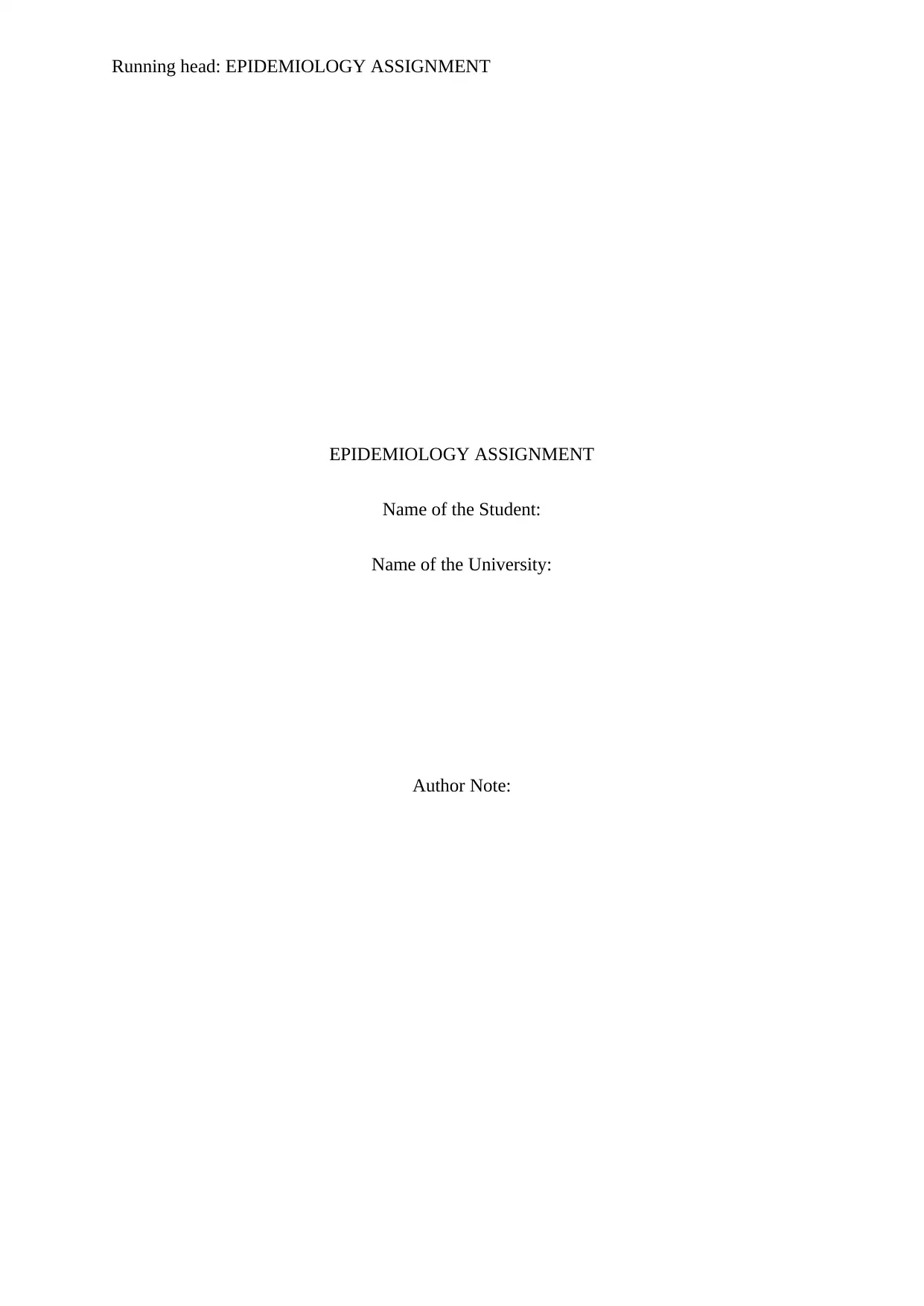
Running head: EPIDEMIOLOGY ASSIGNMENT
EPIDEMIOLOGY ASSIGNMENT
Name of the Student:
Name of the University:
Author Note:
EPIDEMIOLOGY ASSIGNMENT
Name of the Student:
Name of the University:
Author Note:
Paraphrase This Document
Need a fresh take? Get an instant paraphrase of this document with our AI Paraphraser
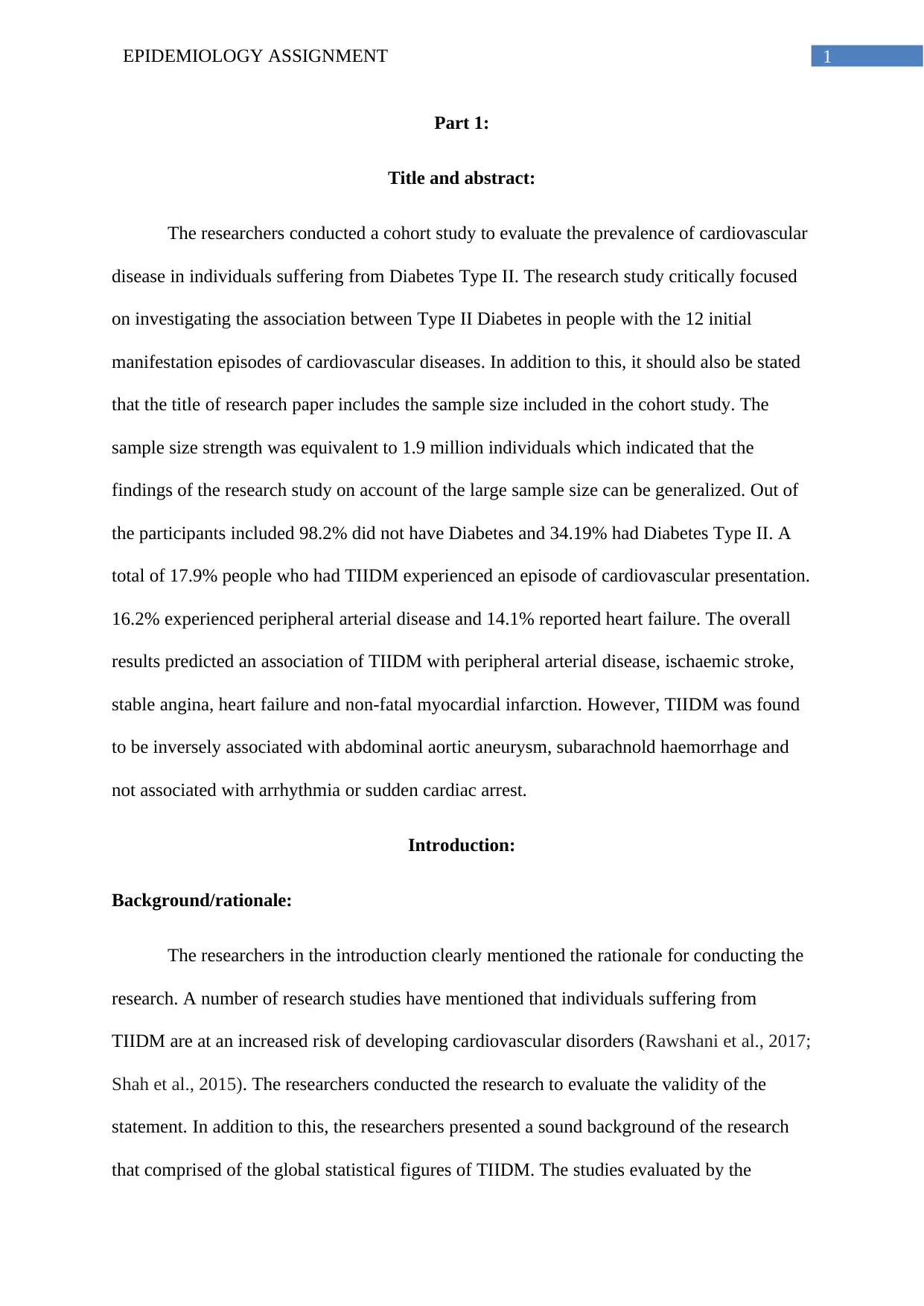
1EPIDEMIOLOGY ASSIGNMENT
Part 1:
Title and abstract:
The researchers conducted a cohort study to evaluate the prevalence of cardiovascular
disease in individuals suffering from Diabetes Type II. The research study critically focused
on investigating the association between Type II Diabetes in people with the 12 initial
manifestation episodes of cardiovascular diseases. In addition to this, it should also be stated
that the title of research paper includes the sample size included in the cohort study. The
sample size strength was equivalent to 1.9 million individuals which indicated that the
findings of the research study on account of the large sample size can be generalized. Out of
the participants included 98.2% did not have Diabetes and 34.19% had Diabetes Type II. A
total of 17.9% people who had TIIDM experienced an episode of cardiovascular presentation.
16.2% experienced peripheral arterial disease and 14.1% reported heart failure. The overall
results predicted an association of TIIDM with peripheral arterial disease, ischaemic stroke,
stable angina, heart failure and non-fatal myocardial infarction. However, TIIDM was found
to be inversely associated with abdominal aortic aneurysm, subarachnold haemorrhage and
not associated with arrhythmia or sudden cardiac arrest.
Introduction:
Background/rationale:
The researchers in the introduction clearly mentioned the rationale for conducting the
research. A number of research studies have mentioned that individuals suffering from
TIIDM are at an increased risk of developing cardiovascular disorders (Rawshani et al., 2017;
Shah et al., 2015). The researchers conducted the research to evaluate the validity of the
statement. In addition to this, the researchers presented a sound background of the research
that comprised of the global statistical figures of TIIDM. The studies evaluated by the
Part 1:
Title and abstract:
The researchers conducted a cohort study to evaluate the prevalence of cardiovascular
disease in individuals suffering from Diabetes Type II. The research study critically focused
on investigating the association between Type II Diabetes in people with the 12 initial
manifestation episodes of cardiovascular diseases. In addition to this, it should also be stated
that the title of research paper includes the sample size included in the cohort study. The
sample size strength was equivalent to 1.9 million individuals which indicated that the
findings of the research study on account of the large sample size can be generalized. Out of
the participants included 98.2% did not have Diabetes and 34.19% had Diabetes Type II. A
total of 17.9% people who had TIIDM experienced an episode of cardiovascular presentation.
16.2% experienced peripheral arterial disease and 14.1% reported heart failure. The overall
results predicted an association of TIIDM with peripheral arterial disease, ischaemic stroke,
stable angina, heart failure and non-fatal myocardial infarction. However, TIIDM was found
to be inversely associated with abdominal aortic aneurysm, subarachnold haemorrhage and
not associated with arrhythmia or sudden cardiac arrest.
Introduction:
Background/rationale:
The researchers in the introduction clearly mentioned the rationale for conducting the
research. A number of research studies have mentioned that individuals suffering from
TIIDM are at an increased risk of developing cardiovascular disorders (Rawshani et al., 2017;
Shah et al., 2015). The researchers conducted the research to evaluate the validity of the
statement. In addition to this, the researchers presented a sound background of the research
that comprised of the global statistical figures of TIIDM. The studies evaluated by the
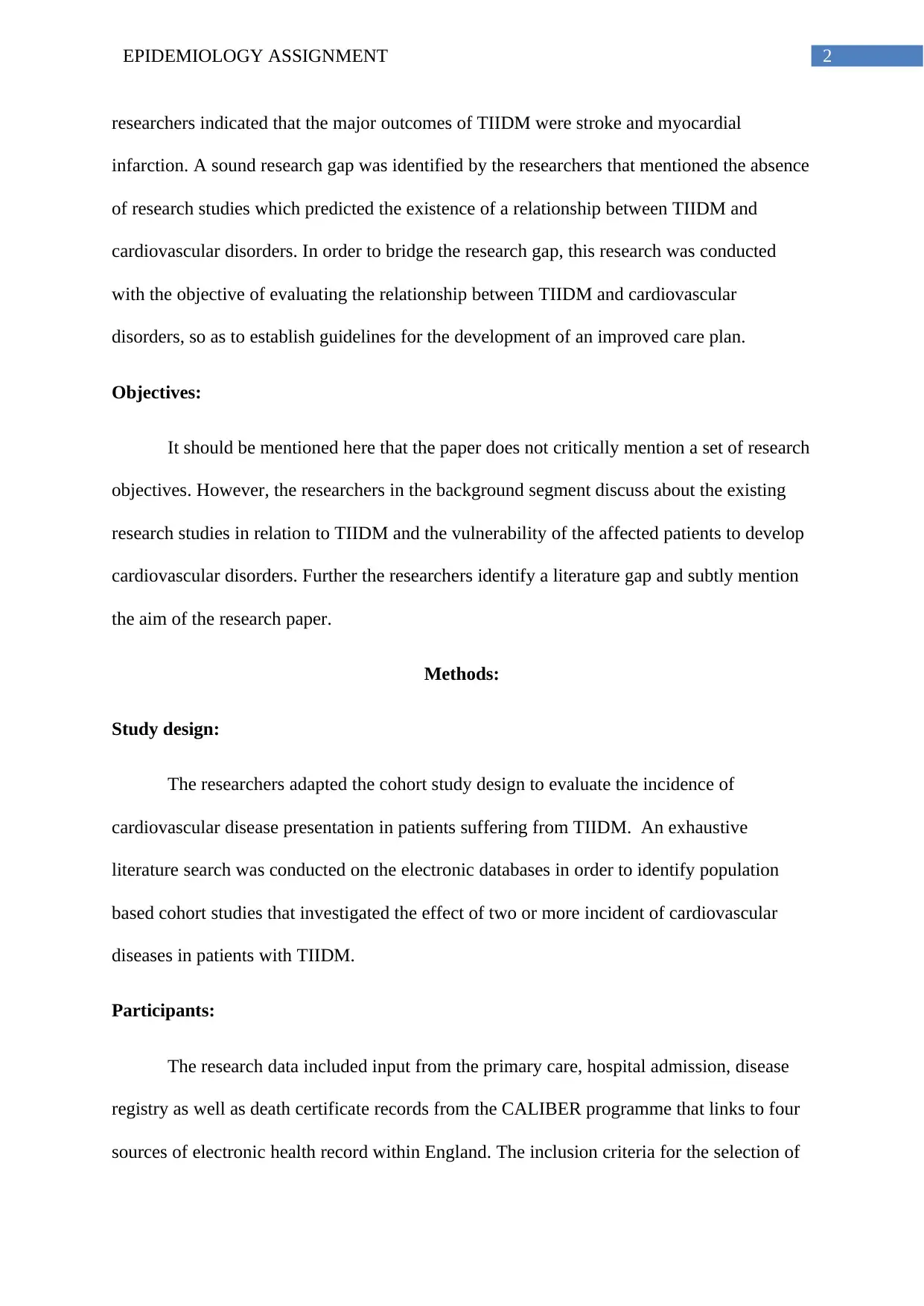
2EPIDEMIOLOGY ASSIGNMENT
researchers indicated that the major outcomes of TIIDM were stroke and myocardial
infarction. A sound research gap was identified by the researchers that mentioned the absence
of research studies which predicted the existence of a relationship between TIIDM and
cardiovascular disorders. In order to bridge the research gap, this research was conducted
with the objective of evaluating the relationship between TIIDM and cardiovascular
disorders, so as to establish guidelines for the development of an improved care plan.
Objectives:
It should be mentioned here that the paper does not critically mention a set of research
objectives. However, the researchers in the background segment discuss about the existing
research studies in relation to TIIDM and the vulnerability of the affected patients to develop
cardiovascular disorders. Further the researchers identify a literature gap and subtly mention
the aim of the research paper.
Methods:
Study design:
The researchers adapted the cohort study design to evaluate the incidence of
cardiovascular disease presentation in patients suffering from TIIDM. An exhaustive
literature search was conducted on the electronic databases in order to identify population
based cohort studies that investigated the effect of two or more incident of cardiovascular
diseases in patients with TIIDM.
Participants:
The research data included input from the primary care, hospital admission, disease
registry as well as death certificate records from the CALIBER programme that links to four
sources of electronic health record within England. The inclusion criteria for the selection of
researchers indicated that the major outcomes of TIIDM were stroke and myocardial
infarction. A sound research gap was identified by the researchers that mentioned the absence
of research studies which predicted the existence of a relationship between TIIDM and
cardiovascular disorders. In order to bridge the research gap, this research was conducted
with the objective of evaluating the relationship between TIIDM and cardiovascular
disorders, so as to establish guidelines for the development of an improved care plan.
Objectives:
It should be mentioned here that the paper does not critically mention a set of research
objectives. However, the researchers in the background segment discuss about the existing
research studies in relation to TIIDM and the vulnerability of the affected patients to develop
cardiovascular disorders. Further the researchers identify a literature gap and subtly mention
the aim of the research paper.
Methods:
Study design:
The researchers adapted the cohort study design to evaluate the incidence of
cardiovascular disease presentation in patients suffering from TIIDM. An exhaustive
literature search was conducted on the electronic databases in order to identify population
based cohort studies that investigated the effect of two or more incident of cardiovascular
diseases in patients with TIIDM.
Participants:
The research data included input from the primary care, hospital admission, disease
registry as well as death certificate records from the CALIBER programme that links to four
sources of electronic health record within England. The inclusion criteria for the selection of
⊘ This is a preview!⊘
Do you want full access?
Subscribe today to unlock all pages.

Trusted by 1+ million students worldwide
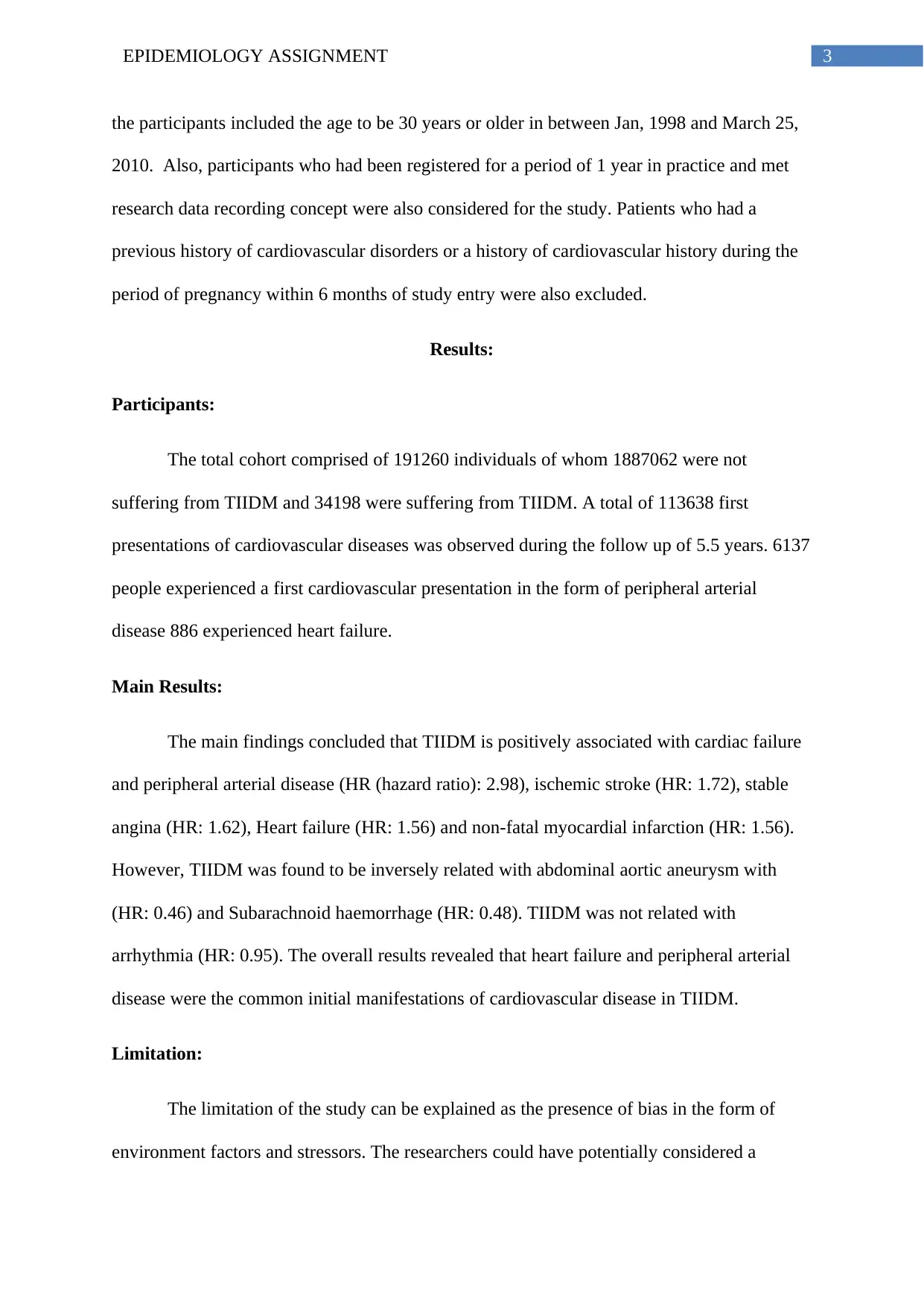
3EPIDEMIOLOGY ASSIGNMENT
the participants included the age to be 30 years or older in between Jan, 1998 and March 25,
2010. Also, participants who had been registered for a period of 1 year in practice and met
research data recording concept were also considered for the study. Patients who had a
previous history of cardiovascular disorders or a history of cardiovascular history during the
period of pregnancy within 6 months of study entry were also excluded.
Results:
Participants:
The total cohort comprised of 191260 individuals of whom 1887062 were not
suffering from TIIDM and 34198 were suffering from TIIDM. A total of 113638 first
presentations of cardiovascular diseases was observed during the follow up of 5.5 years. 6137
people experienced a first cardiovascular presentation in the form of peripheral arterial
disease 886 experienced heart failure.
Main Results:
The main findings concluded that TIIDM is positively associated with cardiac failure
and peripheral arterial disease (HR (hazard ratio): 2.98), ischemic stroke (HR: 1.72), stable
angina (HR: 1.62), Heart failure (HR: 1.56) and non-fatal myocardial infarction (HR: 1.56).
However, TIIDM was found to be inversely related with abdominal aortic aneurysm with
(HR: 0.46) and Subarachnoid haemorrhage (HR: 0.48). TIIDM was not related with
arrhythmia (HR: 0.95). The overall results revealed that heart failure and peripheral arterial
disease were the common initial manifestations of cardiovascular disease in TIIDM.
Limitation:
The limitation of the study can be explained as the presence of bias in the form of
environment factors and stressors. The researchers could have potentially considered a
the participants included the age to be 30 years or older in between Jan, 1998 and March 25,
2010. Also, participants who had been registered for a period of 1 year in practice and met
research data recording concept were also considered for the study. Patients who had a
previous history of cardiovascular disorders or a history of cardiovascular history during the
period of pregnancy within 6 months of study entry were also excluded.
Results:
Participants:
The total cohort comprised of 191260 individuals of whom 1887062 were not
suffering from TIIDM and 34198 were suffering from TIIDM. A total of 113638 first
presentations of cardiovascular diseases was observed during the follow up of 5.5 years. 6137
people experienced a first cardiovascular presentation in the form of peripheral arterial
disease 886 experienced heart failure.
Main Results:
The main findings concluded that TIIDM is positively associated with cardiac failure
and peripheral arterial disease (HR (hazard ratio): 2.98), ischemic stroke (HR: 1.72), stable
angina (HR: 1.62), Heart failure (HR: 1.56) and non-fatal myocardial infarction (HR: 1.56).
However, TIIDM was found to be inversely related with abdominal aortic aneurysm with
(HR: 0.46) and Subarachnoid haemorrhage (HR: 0.48). TIIDM was not related with
arrhythmia (HR: 0.95). The overall results revealed that heart failure and peripheral arterial
disease were the common initial manifestations of cardiovascular disease in TIIDM.
Limitation:
The limitation of the study can be explained as the presence of bias in the form of
environment factors and stressors. The researchers could have potentially considered a
Paraphrase This Document
Need a fresh take? Get an instant paraphrase of this document with our AI Paraphraser
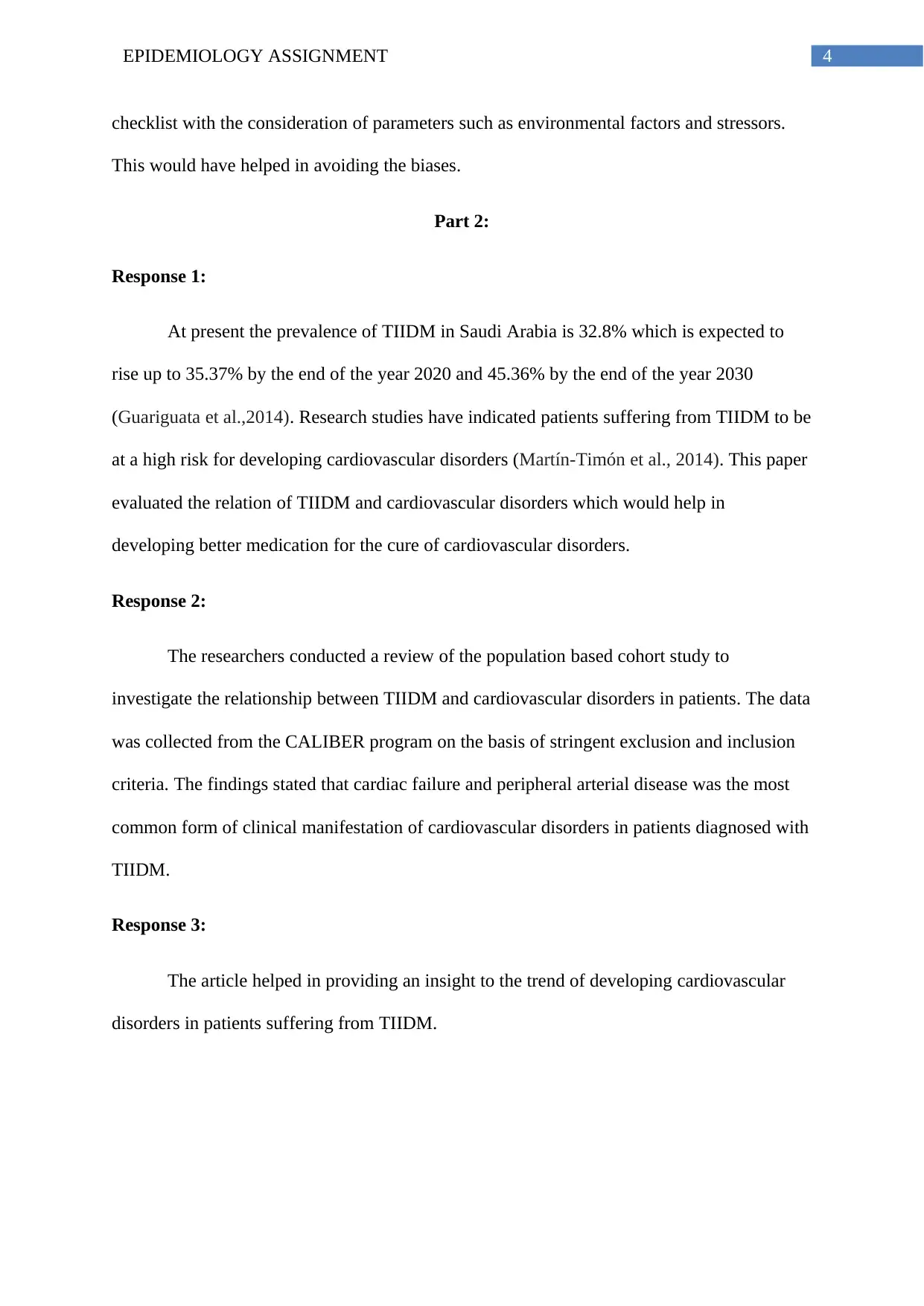
4EPIDEMIOLOGY ASSIGNMENT
checklist with the consideration of parameters such as environmental factors and stressors.
This would have helped in avoiding the biases.
Part 2:
Response 1:
At present the prevalence of TIIDM in Saudi Arabia is 32.8% which is expected to
rise up to 35.37% by the end of the year 2020 and 45.36% by the end of the year 2030
(Guariguata et al.,2014). Research studies have indicated patients suffering from TIIDM to be
at a high risk for developing cardiovascular disorders (Martín-Timón et al., 2014). This paper
evaluated the relation of TIIDM and cardiovascular disorders which would help in
developing better medication for the cure of cardiovascular disorders.
Response 2:
The researchers conducted a review of the population based cohort study to
investigate the relationship between TIIDM and cardiovascular disorders in patients. The data
was collected from the CALIBER program on the basis of stringent exclusion and inclusion
criteria. The findings stated that cardiac failure and peripheral arterial disease was the most
common form of clinical manifestation of cardiovascular disorders in patients diagnosed with
TIIDM.
Response 3:
The article helped in providing an insight to the trend of developing cardiovascular
disorders in patients suffering from TIIDM.
checklist with the consideration of parameters such as environmental factors and stressors.
This would have helped in avoiding the biases.
Part 2:
Response 1:
At present the prevalence of TIIDM in Saudi Arabia is 32.8% which is expected to
rise up to 35.37% by the end of the year 2020 and 45.36% by the end of the year 2030
(Guariguata et al.,2014). Research studies have indicated patients suffering from TIIDM to be
at a high risk for developing cardiovascular disorders (Martín-Timón et al., 2014). This paper
evaluated the relation of TIIDM and cardiovascular disorders which would help in
developing better medication for the cure of cardiovascular disorders.
Response 2:
The researchers conducted a review of the population based cohort study to
investigate the relationship between TIIDM and cardiovascular disorders in patients. The data
was collected from the CALIBER program on the basis of stringent exclusion and inclusion
criteria. The findings stated that cardiac failure and peripheral arterial disease was the most
common form of clinical manifestation of cardiovascular disorders in patients diagnosed with
TIIDM.
Response 3:
The article helped in providing an insight to the trend of developing cardiovascular
disorders in patients suffering from TIIDM.
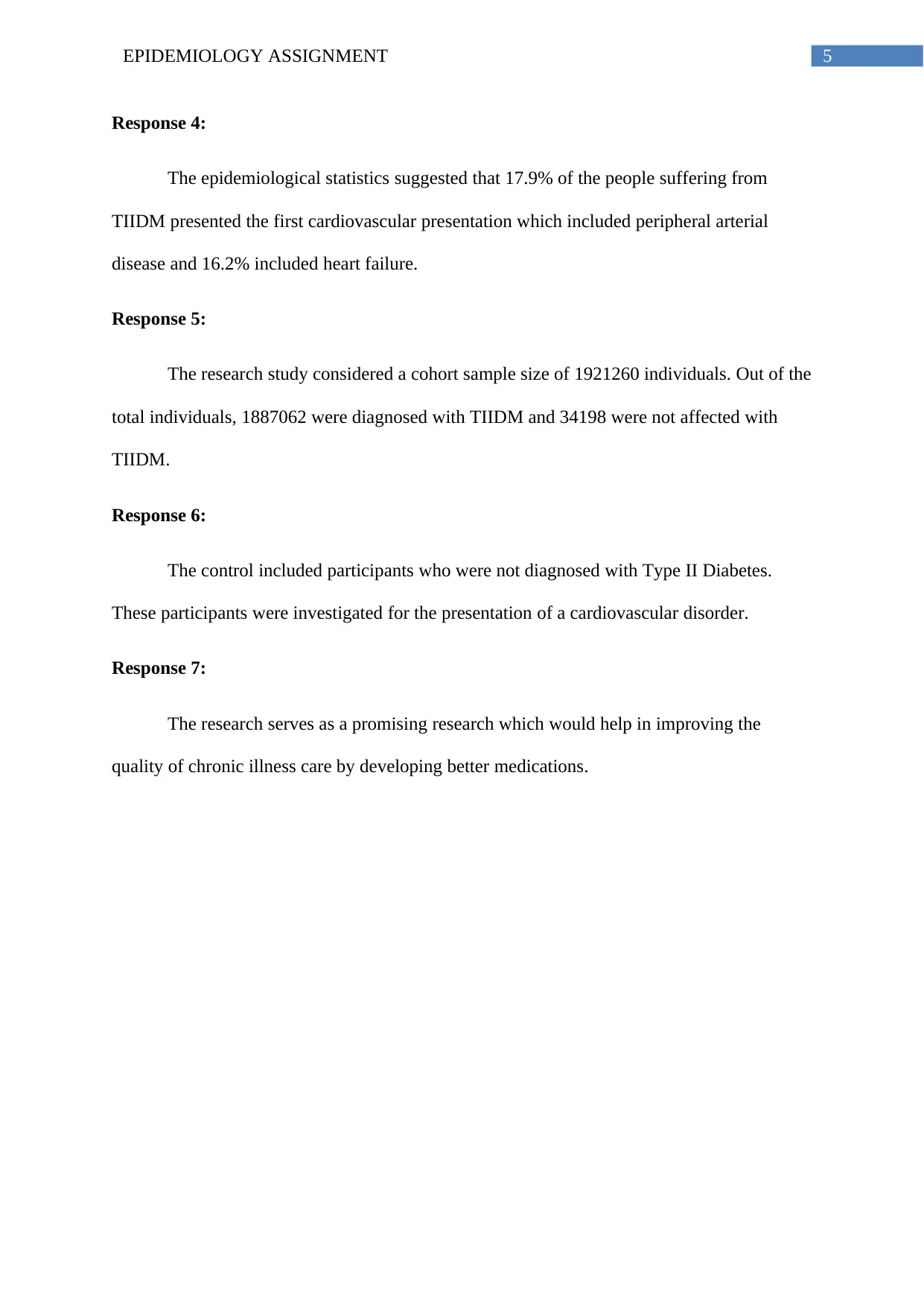
5EPIDEMIOLOGY ASSIGNMENT
Response 4:
The epidemiological statistics suggested that 17.9% of the people suffering from
TIIDM presented the first cardiovascular presentation which included peripheral arterial
disease and 16.2% included heart failure.
Response 5:
The research study considered a cohort sample size of 1921260 individuals. Out of the
total individuals, 1887062 were diagnosed with TIIDM and 34198 were not affected with
TIIDM.
Response 6:
The control included participants who were not diagnosed with Type II Diabetes.
These participants were investigated for the presentation of a cardiovascular disorder.
Response 7:
The research serves as a promising research which would help in improving the
quality of chronic illness care by developing better medications.
Response 4:
The epidemiological statistics suggested that 17.9% of the people suffering from
TIIDM presented the first cardiovascular presentation which included peripheral arterial
disease and 16.2% included heart failure.
Response 5:
The research study considered a cohort sample size of 1921260 individuals. Out of the
total individuals, 1887062 were diagnosed with TIIDM and 34198 were not affected with
TIIDM.
Response 6:
The control included participants who were not diagnosed with Type II Diabetes.
These participants were investigated for the presentation of a cardiovascular disorder.
Response 7:
The research serves as a promising research which would help in improving the
quality of chronic illness care by developing better medications.
⊘ This is a preview!⊘
Do you want full access?
Subscribe today to unlock all pages.

Trusted by 1+ million students worldwide
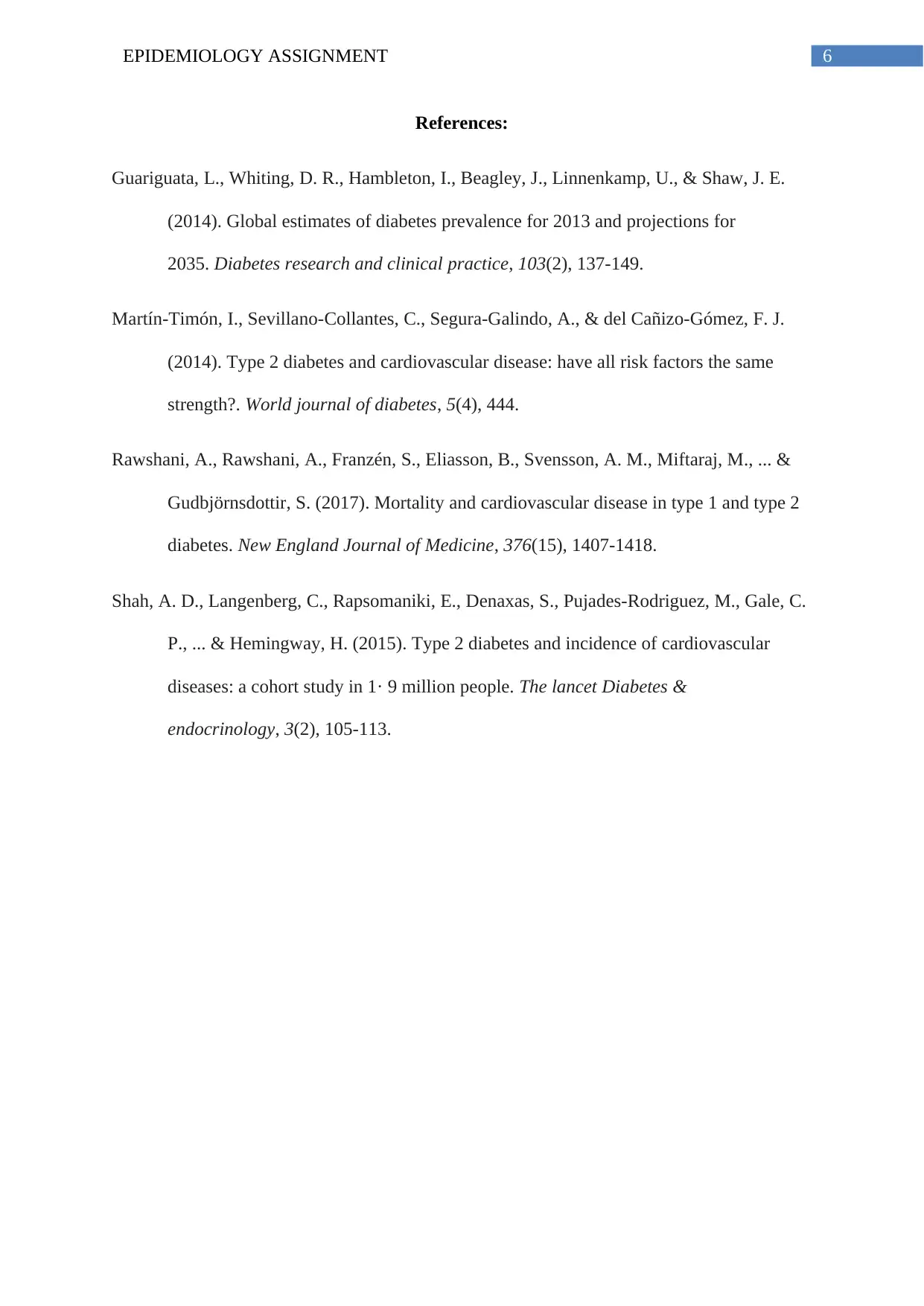
6EPIDEMIOLOGY ASSIGNMENT
References:
Guariguata, L., Whiting, D. R., Hambleton, I., Beagley, J., Linnenkamp, U., & Shaw, J. E.
(2014). Global estimates of diabetes prevalence for 2013 and projections for
2035. Diabetes research and clinical practice, 103(2), 137-149.
Martín-Timón, I., Sevillano-Collantes, C., Segura-Galindo, A., & del Cañizo-Gómez, F. J.
(2014). Type 2 diabetes and cardiovascular disease: have all risk factors the same
strength?. World journal of diabetes, 5(4), 444.
Rawshani, A., Rawshani, A., Franzén, S., Eliasson, B., Svensson, A. M., Miftaraj, M., ... &
Gudbjörnsdottir, S. (2017). Mortality and cardiovascular disease in type 1 and type 2
diabetes. New England Journal of Medicine, 376(15), 1407-1418.
Shah, A. D., Langenberg, C., Rapsomaniki, E., Denaxas, S., Pujades-Rodriguez, M., Gale, C.
P., ... & Hemingway, H. (2015). Type 2 diabetes and incidence of cardiovascular
diseases: a cohort study in 1· 9 million people. The lancet Diabetes &
endocrinology, 3(2), 105-113.
References:
Guariguata, L., Whiting, D. R., Hambleton, I., Beagley, J., Linnenkamp, U., & Shaw, J. E.
(2014). Global estimates of diabetes prevalence for 2013 and projections for
2035. Diabetes research and clinical practice, 103(2), 137-149.
Martín-Timón, I., Sevillano-Collantes, C., Segura-Galindo, A., & del Cañizo-Gómez, F. J.
(2014). Type 2 diabetes and cardiovascular disease: have all risk factors the same
strength?. World journal of diabetes, 5(4), 444.
Rawshani, A., Rawshani, A., Franzén, S., Eliasson, B., Svensson, A. M., Miftaraj, M., ... &
Gudbjörnsdottir, S. (2017). Mortality and cardiovascular disease in type 1 and type 2
diabetes. New England Journal of Medicine, 376(15), 1407-1418.
Shah, A. D., Langenberg, C., Rapsomaniki, E., Denaxas, S., Pujades-Rodriguez, M., Gale, C.
P., ... & Hemingway, H. (2015). Type 2 diabetes and incidence of cardiovascular
diseases: a cohort study in 1· 9 million people. The lancet Diabetes &
endocrinology, 3(2), 105-113.
1 out of 7
Related Documents
Your All-in-One AI-Powered Toolkit for Academic Success.
+13062052269
info@desklib.com
Available 24*7 on WhatsApp / Email
![[object Object]](/_next/static/media/star-bottom.7253800d.svg)
Unlock your academic potential
Copyright © 2020–2025 A2Z Services. All Rights Reserved. Developed and managed by ZUCOL.





